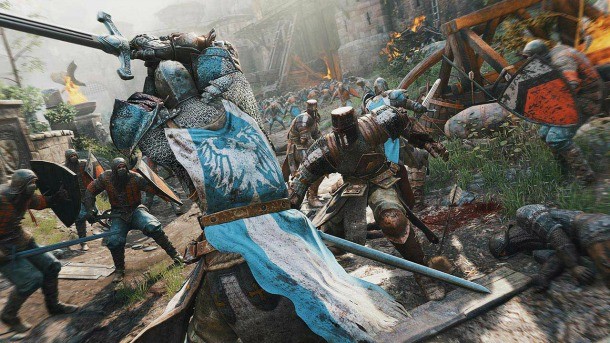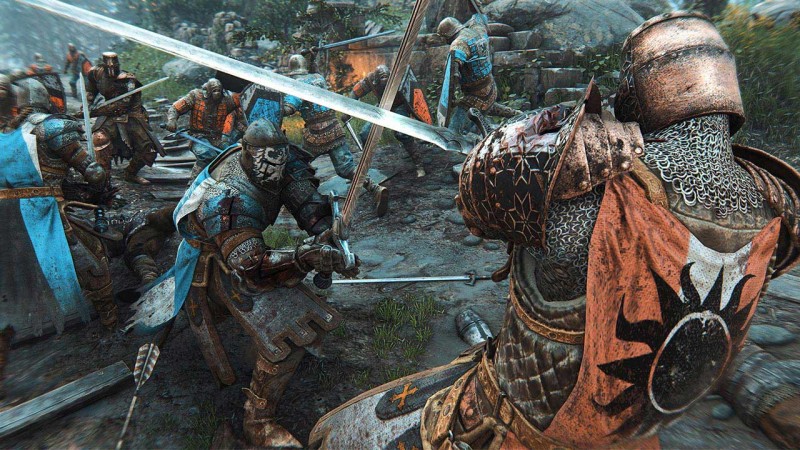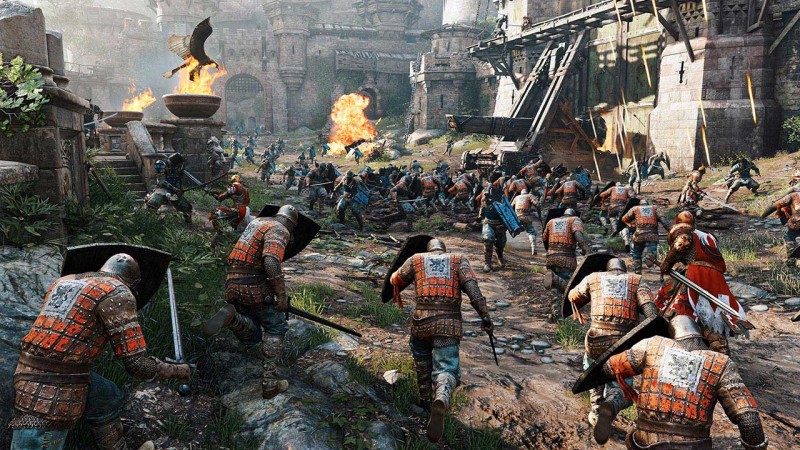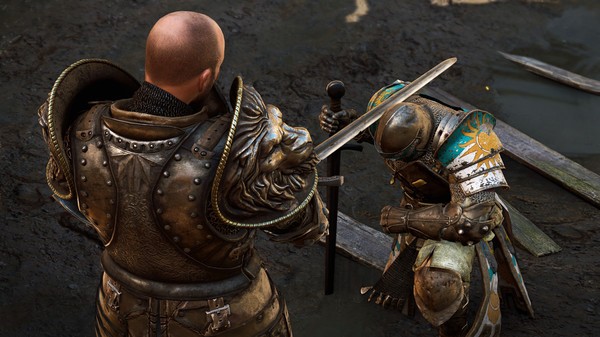Our extra-large special edition is here. Subscribe today and receive the 25% longer issue at no extra cost!
For Honor Is The Fighting Game For People Who Don't Like Fighting Games

Strutting around an alcove atop a dilapidated castle as a Shugoki – a hulking brute wielding a giant kanabo club weapon – I see a Valkyrie quickly approaching. I’ve fought her before, and I know her playstyle: Go for the guard break to disarm defenses, then relentlessly attempt to push the enemy off the edge.
I know what’s going to happen before we fight: thinking that I think it’s ridiculous to go for a guard break five times in a row, that’s exactly what she plans to do. So I club her five times in a row, shutting her down and whittling away most of her health. Desperate for a kill, she jumps backward into a defensive stance, hoping to charge forward and knock me off the edge. I don’t see it coming, but I don’t have to: My hulking body can withstand a single hit without flinching, so when I spread my arms to go for a bear hug, I swipe her up mid-charge and finish her.
After playing it for over a week now, I have no doubt For Honor is a fighting game. It taps a lot of the same highs as a fighting game, and I’m eager to keep digging into its intricate and rewarding combat system. But you wouldn’t call For Honor a fighting game at first glance; parts of how it’s put together, both in and outside of matches, may make you think it hews more closely to other genres. But the more I play it, the more I think that’s the most brilliant thing about it: By borrowing heavily from other genres, For Honor ends up being the fighting game for people who don’t typically like fighting games.

For Honor and traditional fighting games have a lot in common. You can pick from several characters, all of whom play differently; some characters fare better against others, etc. That’s a large part of the appeal of these games (being able to find a character that speaks to you in some way and making them your own), but I won’t delve too much into it here, since these characteristics also apply to all manner of class-based games, like Dota 2 or Overwatch.
For Honor’s combat system divests it from other class-based games and establishes it firmly as a fighter. The core of this system is a sort of “rock, paper, scissors, plus,” an educated guessing game where every option has an appropriate response. Blocking beats attacks coming in from the same direction (right, left, or up), guard breaks beat blocking, and attacks (or a reciprocal guard break) beat guard breaks.
This cycle maps neatly to a traditional fighting game, where attacks beat throws, blocking beats attacks, and throws beat blocking. But what makes fighting games so fun to play is that the cycle is never that neat. Moving away from the opponent can beat many of these options, and characters introduce their own twists (like the Shugoki’s throw). So rather than work as a closed circle (like rock, paper, scissors does), you can imagine For Honor’s combat as a series of interlocking circles, which is what makes each match special.
Fighting games are an intimidating genre. Most people tell me they avoid them because they’d just suck at them, and I think that has to do with a lot of the genre’s DNA. The controls of most fighters games are fluid, but unlike anything else in gaming. It’s hard to know what you’re doing wrong when you first start playing, and losing isn’t much fun when you get beat by the same trick over and over. In combo-heavy games, losing an exchange means not getting to play for a few seconds. And unlike team-based games, it’s hard to blame anyone but yourself after a loss, which means a string of them can devastate the ego.

The ways For Honor diverges from the fighting genre not only make it a beast of its own, but also more approachable to the average player. It takes place from a behind-the-back third-person perspective, which makes it feel immediately familiar to most players. It plays very different from the typical third-person action games, but the basics of moving, locking onto enemies, and using two buttons for light and heavy attacks are in line with most third-person action games.
The third-person view also makes it easier to craft a story around. One of fighting games’ biggest issues in creating compelling story modes is that their limited play areas and diorama perspectives make it hard to craft an engaging tale using the gameplay itself. For Honor breezes by this issue because its perspective and emphasis on movement make it better suited to tell for a story that moves from one area to the next. This is key because playing For Honor’s story mode, it feels like you’re playing a regular third-person action game instead of a tutorial, which lets you ease into the game’s systems without being overwhelmed.
For Honor is also much slower and filled with more iconography than most fighting games. Most attacks or movements come out slowly in part because you need to be able to react to them by blocking in the right direction. Most moves also have some sort of icon bound to them: along with the directional attack icons, guard breaks, throws, and unblockable moves that have obvious visual symbols attached to them. These two things make it easier for newer players to figure out what they’re doing wrong after losing a fight.
Combos, one of the best ways of making the most out of every opening in a fighting game, are also much simpler, maxing out at about four button presses. This is important because while they’re one of my favorite parts of fighting games, they can act as an obstacle for new players. Having to learn intricate sequences of attacks in order to compete at a higher level can scare off new players, and it’s demoralizing to be on the receiving end. New players still have to study each character’s move list before getting the most out of them in For Honor, but they won’t have to spend much time drilling them into muscle memory, which maximizes the amount of time they spend playing actual matches.

For Honor is also well suited for team-based modes like the ones you find in first-person shooters, which further helps ease players in. Dominion, a capture-point mode, is still the game’s most popular mode as of this writing, and it also happens to be the one where the core fighting system is least important. New players can make an impact by capturing points, holding them to increase their point gains, or slaughtering waves of the non-playable soldiers that occupy each map’s middle capture point. Many players fear having to jump into the deep end and test themselves against other players directly, so Dominion adds a great starting point as players to learn how to use the combat system against other players.
The rest of the modes offer a great slope for players to slowly build their confidence in combat, too. Elimination mode has the same team dynamics as Dominion, but emphasizes combat a bit more by eliminating capture points. The two-versus-two mode emphasizes combat almost exclusively, but still has an element of teamplay that takes some of the pressure off each player. Once you’ve become good enough to believe your online teammates are weighing you down, you can try your hand at one-versus-one duels, where For Honor most resembles a traditional fighter. So as you become more confident in your own combat prowess, you scale how much that matters to your liking.
This isn’t to say For Honor is an easy game to learn – the more I play of it, the more nuances I find, and I wouldn’t say I’ve completely wrapped my head around every aspect of combat. But, anecdotally, more people in the Game Informer office have been playing For Honor regularly than most fighting games I can think of. And online, it’s proving to be popular for the time being, with high Twitch viewership and more than 70,000 Reddit subscribers.
I don’t think For Honor is some sort of landmark entry point for the genre the way Street Fighter IV was. All of these differences make it easier to approach, but I’m doubtful about dedicated For Honor players transitioning to other fighting games, because while feeding off similar concepts, the two feel very different. But I do think it shares enough elements with fighting games to help people understand why their core elements are so fun, and why the high of winning at “rock, paper, scissors, plus” is worth chasing. That, if nothing else, is a victory.

Get the Game Informer Print Edition!
Explore your favorite games in premium print format, delivered to your door.
- 10 issues per year
- Only $4.80 per issue
- Full digital magazine archive access
- Since 1991









